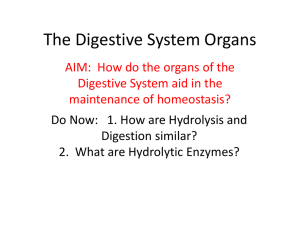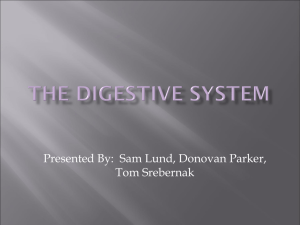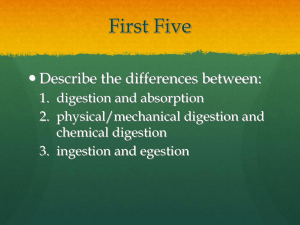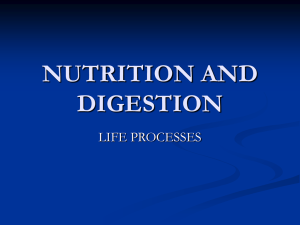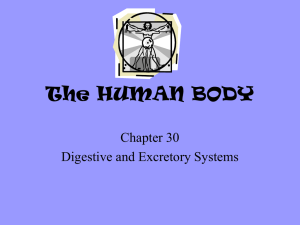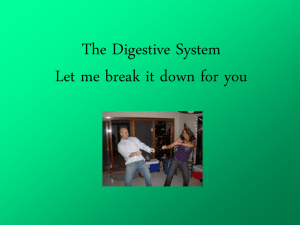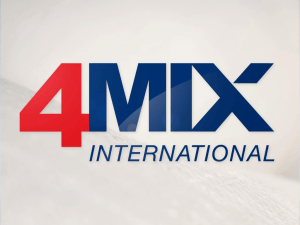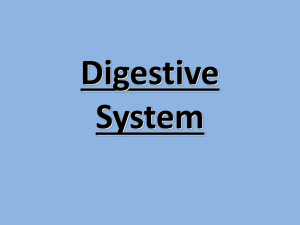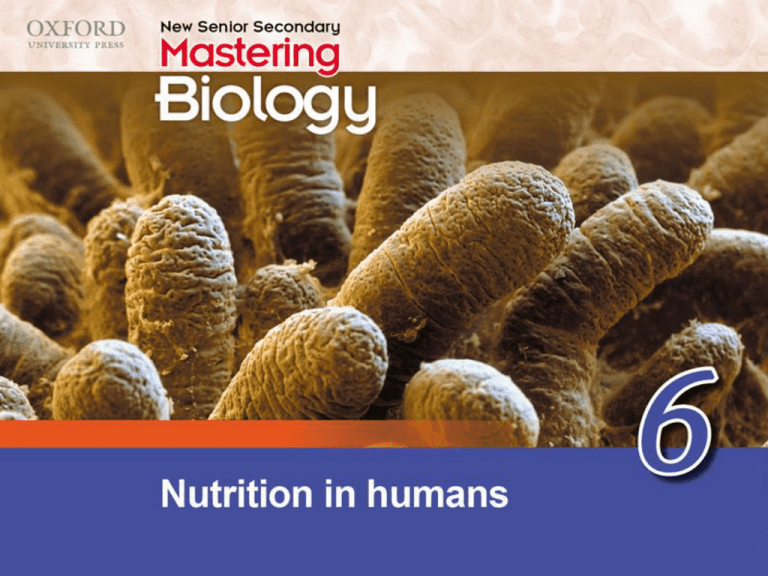
1
Think about…
6.1 The process of human nutrition
6.2 The human digestive system
6.3 Ingestion of food
6.4 Movement of food along the alimentary canal
6.5 Digestion of food
6.6 Absorption of digested food
6.7 Assimilation of absorbed food
6.8 Egestion
Recall ‘Think about…’
Summary concept map
2
Weight loss surgery
can help obese
people lose weight
3
stomach
ileum
small bag created at the
top of stomach
it connects directly to
ileum
food bypasses larger
stomach and duodenum
duodenum
4
1
What is the role
of the stomach
5
2
How does the
surgery help people
lose weight
6
3
What will happen
if the food does not
pass through the
ileum also
7
6.1 The processes of human
nutrition
food
1 ingestion
(攝食)
2 digestion
(消化)
complex and
insoluble food
molecules
simple and
soluble food
molecules
8
6.1 The processes of human
nutrition
1 ingestion
(攝食)
2 digestion
(消化)
5 egestion
(排遺)
digested
3 absorption
food
(吸收)
4 assimilation
(同化)
9
faeces
6.1 The processes of human nutrition
The five main processes of
nutrition in humans are ingestion
digestion , absorption ,
assimilation and egestion .
10
6.2 The human digestive system
What does our
digestive system
(消化系統) consist of?
11
6.2 The human digestive system
Digestive system
Alimentary canal
(消化道)
Glands
(腺)
12
6.2 The human digestive system
Alimentary canal
1 mouth cavity
2 pharynx (咽)
3 oesophagus (食道)
4 stomach
13
6.2 The human digestive system
Alimentary canal
duodenum
5 small intestine
6 large intestine
ileum
colon
rectum
7 anus (肛門)
14
6.2 The human digestive system
Glands
salivary glands
pancreas (胰)
liver
15
6.2 The human digestive system
6.1
Video
Examination of the mammalian
alimentary canal and its associated
glands
1 Examine the digestive system of a
dissected rat (or a human torso model).
16
17
6.2 The human digestive system
6.1
2 Identify the structures
as shown in the figure.
18
6.2 The human digestive system
1
Our digestive system consists
of the alimentary canal and
its associated glands .
19
6.2 The human digestive system
2
Alimentary canal:
mouth cavity
pharynx
start
oesophagus
stomach
small intestine
end
anus
large intestine
20
6.2 The human digestive system
3
Associated glands:
salivary glands , pancreas ,
liver
21
6.3 Ingestion of food
mouth cavity
• food is taken in through the mouth
22
6.3 Ingestion of food
teeth
• mastication (咀嚼): chewing food
into small pieces
23
24
6.3 Ingestion of food
A) Types of teeth
1 Incisors (門齒)
• for biting and cutting food
chisel-shaped
(鑿形的)
flat sharp edges
one root
25
6.3 Ingestion of food
A) Types of teeth
2 Canine (犬齒)
• well-developed in carnivores
• for tearing flesh
pointed and curved
one root
26
6.3 Ingestion of food
A) Types of teeth
3 Premolar (前臼齒)
• for cutting and grinding
food
broad top with cusps
1 or 2 roots
27
6.3 Ingestion of food
A) Types of teeth
4 Molar (臼齒)
• similar to premolar but
larger
2 or 3 roots
28
6.3 Ingestion of food
B) Structure of a tooth
• divided into
crown
(齒冠)
neck
(齒頸)
root
(齒根)
29
6.3 Ingestion of food
1 Enamel (琺瑯質)
• the outermost, hardest
region
• non-living and is made
mainly of calcium salt
• protects teeth from
wearing off
30
6.3 Ingestion of food
1 Enamel (琺瑯質)
Around the roots…
• replaced by cement
(牙骨質)
• fibres from cement
form periodontal
membrane (牙周膜)
cement
periodontal
membrane
31
6.3 Ingestion of food
2 Dentine (牙本質)
• the middle region of the
tooth
• contains strands of
living cytoplasm
32
6.3 Ingestion of food
3 Pulp cavity (髓腔)
living cells
nerve fibres
blood vessels
33
6.3 Ingestion of food
3 Pulp cavity (髓腔)
nerve fibres
• detect temperature and
pressure
blood vessels
• supply oxygen and nutrient
• remove waste
34
6.3 Ingestion of food
C) Dentition of humans
• dentition (齒系): number and
arrangement of different types of teeth
• represented by a dental formula (齒式)
35
6.3 Ingestion of food
C) Dentition of humans
• on each side of the upper jaw:
2 incisors
1 canine
2 premolars
3 molars
36
6.3 Ingestion of food
C) Dentition of humans
• on each side of the lower jaw:
2 incisors
1 canine
2 premolars
3 molars
37
6.3 Ingestion of food
C) Dentition of humans
• dental formula of an adult:
3
2
1
2
i , c , pm , m
3
2 1
2
2123
2123
38
6.3 Ingestion of food
D) Milk teeth and permanent
teeth
• first set of teeth:
milk teeth (乳齒)
• appear during the first
two years
2102
• dental formula:
2102
39
6.3 Ingestion of food
D) Milk teeth and permanent
teeth
• second set of teeth:
permanent teeth (恆齒)
• replace milk teeth
between the ages of
6 and 12
• will not be replaced
when lost
40
6.3 Ingestion of food
D) Milk teeth and permanent
teeth
permanent teeth
milk teeth
41
6.3 Ingestion of food
1 Food is put into the
mouth cavity
and cut up by teeth . The
process of chewing food into
small pieces is called
mastication .
42
6.3 Ingestion of food
2 Match the functions of different
types of teeth:
incisors
canine
premolars
molars
tearing flesh
biting and cutting
crushing and
grinding
43
6.3 Ingestion of food
3a Label the structure of the tooth.
crown
neck
root
44
6.3 Ingestion of food
3b Label the structure of the tooth.
enamel
dentine
pulp cavity
45
6.3 Ingestion of food
4a
Dentition refers to the number
and arrangement of different
types of teeth in a mammal.
It can be represented by a
dental formula .
46
6.3 Ingestion of food
4b Humans have two sets of teeth
in a lifetime:
i) milk teeth
ii) permanent teeth
47
6.4 Movement of food along the
alimentary canal
What will happen to
us after mastication?
48
6.4 Movement of food along the alimentary canal
1 Swallowing
Animation
• before swallowing:
bolus (食團)
Food is chewed
teeth
The tongue shapes
the food into a bolus
tongue
49
6.4 Movement of food along the alimentary canal
1 Swallowing
• during swallowing:
1 The tongue pushes
the bolus towards
pharynx
50
51
6.4 Movement of food along the alimentary canal
1 Swallowing
• during swallowing:
2 The soft palate
(軟腭) moves up to
prevent the bolus
from entering the
nasal cavity
52
6.4 Movement of food along the alimentary canal
1 Swallowing
• during swallowing:
3 The epiglottis (會厭)
covers the trachea
4 The bolus enters
the oesophagus
53
6.4 Movement of food along the alimentary canal
2 Peristalsis (蠕動)
• rhythmic contraction and relaxation of
the muscles
circular
muscle
(環肌)
longitudinal
muscle (縱肌)
lumen (管腔)
alimentary canal
54
6.4 Movement of food along the alimentary canal
2 Peristalsis (蠕動)
circular muscles
contract, longitudinal
muscles relax
circular muscles
relax, longitudinal
muscles contract
food
food moved forward
55
6.4 Movement of food along the alimentary canal
1 Food is moved from the mouth
cavity down the oesophagus
by swallowing and down from
the oesophagus towards the
anus by peristalsis .
56
6.4 Movement of food along the alimentary canal
2 Peristalsis is the rhythmic
contraction and relaxation
of the circular and longitudinal
muscles in the wall of alimentary
canal. It causes the food to move
forward along the canal.
57
6.5 Digestion of food
• undigested food is too large to pass
through the wall
wall of alimentary canal
(differentially permeable)
blood
alimentary
canal
undigested food molecules
58
6.5 Digestion of food
• digestion makes the food smaller,
simpler and soluble for absorption
blood
alimentary
canal
digested food molecules
59
6.5 Digestion of food
Physical digestion (機械消化)
• breaks down food into smaller pieces
• increases surface area for action of
digestive juices (消化酶)
food
physical
action
smaller surface area
larger surface area
60
6.5 Digestion of food
Physical digestion (機械消化)
• examples:
1 Chewing by teeth
2 Churning (劇烈攪動) in
the stomach
61
6.5 Digestion of food
Physical digestion (機械消化)
• examples:
3 Peristalsis along alimentary canal
4 Emulsification (乳化) by bile salts
lipid
s
small droplets
62
6.5 Digestion of food
Chemical digestion (化學消化)
• chemical reactions in which large,
complex food molecules are broken down
digestive enzymes
(消化酶)
large, complex
small, simple
63
6.5 Digestion of food
• three types of digestive enzymes
1 Carbohydrases (碳水化合酶)
e.g. amylase, sucrase and maltase
complex
carbohydrates
simpler sugars
64
6.5 Digestion of food
• three types of digestive enzymes
2 Proteases (蛋白酶)
e.g. pepsin, trypsin and peptidases
polypeptides
protein
peptides
amino acids65
6.5 Digestion of food
• three types of digestive enzymes
3 Lipase (脂肪酶)
e.g. pancreatic lipase
fat
fatty acids
glycerol
66
6.5 Digestion of food
6.2
Design an investigation of the action
of digestive enzymes
Tina’s mother added some powder to the
steaks when she was preparing the dinner.
Tina was curious about the purpose of the
powder.
67
6.5 Digestion of food
6.2
The meat tenderizer contains an
enzyme that can soften the meat.
Our bodies also have a similar
enzyme called pepsin for digestion.
68
6.5 Digestion of food
6.2
Design and perform an investigation to
find out the action of pepsin on protein
digestion.
Is it true?
69
6.5 Digestion of food
Digestion in mouth cavity
• food is chewed into small pieces
and mixed with saliva
Animation
70
71
6.5 Digestion of food
Digestion in mouth cavity
Saliva
• secreted by salivary
glands
• slightly alkaline
salivary glands
72
6.5 Digestion of food
Digestion in mouth cavity
Saliva
• consists of
i) salivary amylase
starch
maltose
ii) mucus (黏液)
- moistens and lubricates (潤滑) food
73
6.5 Digestion of food
Digestion in mouth cavity
Saliva
• consists of
iii) water
- dissolves soluble substances in food
74
6.5 Digestion of food
Digestion in stomach
Structure of the stomach
oesophagus
muscle bag
duodenum
75
6.5 Digestion of food
Digestion in stomach
Structure of the stomach
cardiac sphincter
(賁門括約肌)
- closes the entrance
pyloric sphincter
(幽門括約肌)
- regulates the release
of food into duodenum
76
6.5 Digestion of food
Digestion in stomach
Structure of the stomach
gastric glands
inside pits
stomach wall (450)
• gastric glands secrete gastric juice
(胃液)
77
6.5 Digestion of food
Digestion in stomach
Gastric juice
• contains
i) proteases
protein
peptides
78
6.5 Digestion of food
Digestion in stomach
HCl
Gastric juice
• contains
ii) hydrochloric acid
- provides an acidic medium
for the action of proteases
- kills most bacteria in food
bacteria
79
6.5 Digestion of food
Digestion in stomach
Gastric juice
• contains
iii) mucus
- protects stomach from
being damaged by
proteases and
hydrochloric acid
mucus
proteases & HCl
80
6.5 Digestion of food
Digestion in stomach
food
churning &
chemical digestion
semi-solid paste
called chyme (食糜)
81
6.5 Digestion of food
Digestion in small intestine
• three digestive juices
1 Bile
• secreted by liver
• stored in gall bladder
• released to duodenum
through bile duct (膽管)
82
6.5 Digestion of food
Digestion in small intestine
• three digestive juices
1 Bile
• secreted by liver
• stored in gall bladder
• released to duodenum
through bile duct (膽管)
83
6.5 Digestion of food
Digestion in small intestine
1 Bile
• has no enzymes but contains
i) bile salts
- emulsify lipids into small droplets
lipid
s
emulsification
smaller surface area
larger surface
84
area
6.5 Digestion of food
Digestion in small intestine
1 Bile
ii) bile pigments
- give green colour to bile
iii) sodium hydrogencarbonate
- neutralizes the acidic chyme
- provides an alkaline medium for the
actions of enzymes in duodenum
85
6.5 Digestion of food
Digestion in small intestine
1 Bile
Bile is produced by the
gall bladder.
86
6.5 Digestion of food
Digestion in small intestine
1 Bile
Bile is produced by the liver
and temporarily stored in the
gall bladder.
87
6.5 Digestion of food
6.3
Animation
Investigation of the effect of bile salts
on oil
1 Add 10 drops of bile salt
solution to 1 cm3 of
peanut oil.
bile salt
solution
peanut oil
88
89
6.5 Digestion of food
6.3
2 Stopper the test tube and
shake for 30 seconds.
Observe the mixture and
note any changes.
shake
Results and discussion
An emulsion (乳狀物) is formed. This
shows that bile salts can break down lipids
into tiny droplets.
90
6.5 Digestion of food
Digestion in small intestine
2 Pancreatic juice
• secreted by pancreas
pancreatic duct
• released to duodenum
through pancreatic duct
• slightly alkaline
pancreas
91
6.5 Digestion of food
Digestion in small intestine
2 Pancreatic juice
• contains:
i) pancreatic amylase
starch
maltose
92
6.5 Digestion of food
Digestion in small intestine
2 Pancreatic juice
• contains:
ii) protease
protein
peptides
93
6.5 Digestion of food
Digestion in small intestine
2 Pancreatic juice
• contains:
ii) protease
peptides
amino acids
94
6.5 Digestion of food
Digestion in small intestine
2 Pancreatic juice
• contains:
iii) lipase
lipid
fatty acids glycerol
95
6.5 Digestion of food
Digestion in small intestine
2 Pancreatic juice
• contains:
iv) sodium hydrogencarbonate
- neutralizes the acidic chyme
- provides an alkaline medium for the
actions of enzymes in duodenum
96
6.5 Digestion of food
Digestion in small intestine
3 Intestinal juice
• secreted by the glands
on the wall of the
small intestine
duodenum
ileum
97
6.5 Digestion of food
Digestion in small intestine
3 Intestinal juice
• slightly alkaline
duodenum
• contains mucus
• no enzymes
ileum
98
6.5 Digestion of food
Digestion in small intestine
• some specialized cells on the wall also
involved in digestion
duodenum
specialized cells
ileum
99
6.5 Digestion of food
Digestion in small intestine
• enzymes present on their cell membrane
duodenum
enzymes
here
specialized cells
ileum
100
6.5 Digestion of food
Digestion in small intestine
• The enzymes include:
i) carbohydrases
disaccharides
monosaccharides
101
6.5 Digestion of food
Digestion in small intestine
• The enzymes include:
ii) proteases
peptides
amino acids
102
6.5 Digestion of food
Digestion in small intestine
• Digestion completed at the end of ileum
monosaccharides
amino acids
glycerol
ready
for
absorption
fatty acids
103
6.5 Digestion of food
1 The food we take in is too
large
to pass through the wall of the
alimentary canal, which is
differentially permeable. Digestion
makes the food smaller , simpler
and soluble for absorption.
104
6.5 Digestion of food
2a
Physical digestion is mainly
brought about by chewing
action of the teeth, churning
in the stomach, peristalsis
along the alimentary canal, and
emulsification of lipids by bile
salts.
105
6.5 Digestion of food
2b
Physical digestion increases
the surface area of food for
chemical digestion.
106
6.5 Digestion of food
3a
Chemical digestion involves
chemical reactions in which
large, complex food molecules
are broken down into smaller,
simpler forms. The reactions
are catalysed
by digestive enzymes .
107
6.5 Digestion of food
3b Some digestive enzymes are
present in the digestive juices
secreted by the digestive glands .
108
6.5 Digestion of food
4a
Digestion of carbohydrates:
Mouth cavity
starch
salivary amylase
in saliva
maltose
Duodenum
pancreatic amylase
maltose
starch
in pancreatic juice
109
6.5 Digestion of food
4a
Digestion of carbohydrates:
Small intestine
disaccharides
monosaccharides
carbohydrases
on the cell membranes
of the specialized cells
in the intestinal wall
110
6.5 Digestion of food
4b
Digestion of proteins:
Stomach
protein
proteases
in gastric juice
peptides
Duodenum
proteases
protein,
peptides,
peptides in pancreatic juice amino acids 111
6.5 Digestion of food
4b
Digestion of proteins:
Small intestine
proteases
amino
peptides
on the cell membrane acids
of the specialized cells
in the intestinal wall
112
6.5 Digestion of food
4c
Digestion of lipids:
Duodenum
lipids
bile salt
in bile
small
droplets
lipase
fatty acids,
lipids
in pancreatic juice glycerol
113
6.6 Absorption of digested food
mainly takes place
in ileum
114
6.6 Absorption of digested food
Adaptation of small intestine
for food absorption
1 Long intestine
• allows sufficient time
for absorption
It’s 7m long!
115
6.6 Absorption of digested food
Adaptation of small intestine
for food absorption
2 Highly-folded
intestinal wall and
numerous villi (絨毛)
epithelium covered
with villi
cross-section of
small intestine
116
6.6 Absorption of digested food
Adaptation of small intestine
for food absorption
2 Highly-folded
intestinal wall and
numerous villi (絨毛)
epithelium covered
with villi
inner surface of
ileum
117
6.6 Absorption of digested food
Adaptive features of villi
1 Finger-like projections
• increases surface area
for absorption
118
6.6 Absorption of digested food
Adaptive features of villi
2 Thin epithelium
• reduces the distance
for diffusion of food
molecules
119
6.6 Absorption of digested food
Adaptive features of villi
lacteal
3 Presence of lacteal and
a network of blood
capillaries
• carry away the absorbed
food molecules rapidly
blood capillary
120
6.6 Absorption of digested food
Adaptive features of villi
4 Movement of villi
caused by peristalsis
• keeps a steep
concentration
gradient of food
molecules
121
6.6 Absorption of digested food
Absorption of digested food
Into the blood
Animation
monosaccharides
diffusion
amino acids
active
transport
minerals
water-soluble
vitamins
122
123
6.6 Absorption of digested food
Absorption of digested food
Into the blood
hepatic
vein
liver
hepatic
portal vein
all parts of
the body
124
6.6 Absorption of digested food
Absorption of digested food
Into the lymph
lumen
epithelium
fatty acid
fatty acid
glycerol
glycerol
lipid
lacteal
lipid
125
6.6 Absorption of digested food
Absorption of digested food
Into the lymph
lymph
vessel
all parts of
the body
126
6.6 Absorption of digested food
Absorption of water
• most water is absorbed in stomach
and small intestine
osmosis
water
blood capillary
127
6.6 Absorption of digested food
6.4
Simulation of digestion and absorption
in the small intestine using dialysis
tubing
1 Tie a knot at one end of a dialysis tubing.
Fill the tubing with equal volumes of
starch solution and amylase solution.
128
6.6 Absorption of digested food
6.4
2 Tie the other end of the tubing.
3 Immerse the tubing in water at
37°C.
dialysis tubing
water at 37oC
starch and amylase
129
6.6 Absorption of digested food
6.4
4 Test the water outside the tubing
immediately for starch and reducing sugars
using iodine solution and Benedict’s
solution respectively. Perform the same
tests after one hour.
130
6.6 Absorption of digested food
6.4
Results and discussion
• At the beginning of the experiment, neither
starch nor reducing sugars are present in the
water. However, reducing sugars are
detected after one hour.
131
6.6 Absorption of digested food
6.4
Results and discussion
• These results show that amylase helps
break down starch into reducing sugars
and only the reducing sugar molecules are
small enough to pass through the dialysis
tubing.
132
6.6 Absorption of digested food
1
Absorption is the movement of
food molecules from the
alimentary canal into the
circulatory system. It takes place
mainly in the ileum.
133
6.6 Absorption of digested food
2a
How is the small intestine
adapted for food absorption?
Adaptation
Significance
Highly-folded
wall and
numerous villi
Increase surface
area for
absorption
134
6.6 Absorption of digested food
2b How is the small intestine
adapted for food absorption?
Adaptation
Significance
Thin epithelium
Reduces the
distance for
diffusion of food
molecules
135
6.6 Absorption of digested food
2c
How is the small intestine
adapted for food absorption?
Adaptation
Significance
Presence of lacteal Carry away the
and a network of
absorbed food
blood capillaries molecules rapidly
136
6.6 Absorption of digested food
2d How is the small intestine
adapted for food absorption?
Adaptation
Significance
Movement of villi
caused by
peristalsis
Keeps a steep
concentration
gradient of food
molecules
137
6.6 Absorption of digested food
3a Monosaccharides, amino acids,
minerals and water-soluble
vitamins are absorbed into the
blood capillaries of the villi by
diffusion and active transport.
They are carried to the liver via
the
hepatic portal vein .
138
6.6 Absorption of digested food
3b Fatty acids and glycerol diffuse
into the epithelium of the villi.
Here they recombine to form
lipids
before entering
the lacteals .
139
6.7 Assimilation of absorbed
food
• the uptake and use of absorbed food
molecules for metabolism
140
6.7 Assimilation of absorbed food
The fate of absorbed food
1 Glucose
i) for releasing energy
respiration
glucose
energy
141
6.7 Assimilation of absorbed food
The fate of absorbed food
1 Glucose
ii) excess glucose is converted into
glycogen or lipid in liver
glycogen
lipid
stored
stored in
liver / muscle
under skin / around
internal organs
142
6.7 Assimilation of absorbed food
The fate of absorbed food
2 Amino acids
i) for making proteins
enzymes
proteins for growth
antibodies
proteins for repair
hormones
ii) excess amino acids are deaminated
in liver
143
6.7 Assimilation of absorbed food
The fate of absorbed food
3 Lipids
i) as energy reserve
ii) for making cell membrane
iii) for protecting internal
organs or reducing heat
loss
subcutaneous fat
144
6.7 Assimilation of absorbed food
The roles of the liver
1 Regulate blood glucose level
• blood glucose level > normal
glucose
liver
glycogen
• blood glucose level < normal
liver
glycogen
glucose
145
6.7 Assimilation of absorbed food
The roles of the liver
2 Storage of glycogen, iron and
fat-soluble vitamins
• main site for storing glycogen
glycogen
146
6.7 Assimilation of absorbed food
The roles of the liver
2 Storage of glycogen, iron and
fat-soluble vitamins
• stores fat-soluble vitamins
vitamin A
vitamin D
147
6.7 Assimilation of absorbed food
The roles of the liver
2 Storage of glycogens, iron
and fat-soluble vitamins
• for storing iron from the breakdown
of red blood cells
red blood cells
iron
148
6.7 Assimilation of absorbed food
The roles of the liver
3 Production of bile, vitamin A
and heat
heat
• secretes bile
• changes carotene to
vitamin A
metabolic
activities
• produces heat
149
6.7 Assimilation of absorbed food
The roles of the liver
4 Deamination
amino group
excess
amino
acids
remaining
parts
urea
carbohydrates
lipids
150
6.7 Assimilation of absorbed food
The roles of the liver
5 Detoxification (解毒)
toxins
(e.g. alcohol,
drugs)
harmless
substances
151
6.7 Assimilation of absorbed food
1
Assimilation is the uptake and
use of absorbed food molecules
by cells for metabolism.
152
6.7 Assimilation of absorbed food
2 How are the absorbed food
molecules assimilated inside cells?
glucose
for releasing energy
amino acids
for making proteins
lipids
for making cell
membrane
as energy reserve
153
6.7 Assimilation of absorbed food
3 The roles of the liver include:
• regulates blood glucose level
• stores glycogen , iron and
fat-soluble vitamins
• produces bile , vitamin A and
heat
154
6.7 Assimilation of absorbed food
3 The roles of the liver include:
• deaminates excess amino acids
• detoxifies mild toxins
155
6.8 Egestion
• the process of expelling faeces (糞便)
from the body
• also called defaecation (排糞)
• faeces consist of
dietary fibre
bacteria
secretions from
alimentary canal
dead cells
156
6.8 Egestion
faeces stored in rectum
temporarily
anal sphincter muscle
relaxes and rectum
muscle contracts to
push the faeces out
157
6.8 Egestion
Egestion is the process of expelling
faeces from the body.
158
1
What is the role of the stomach?
• The stomach churns to break down
food into smaller pieces physically.
• It secretes proteases to chemically
digest proteins.
• It also releases hydrochloric acid
which kills most bacteria in food.
159
2
How does the surgery help people
lose weight?
Without passing through the stomach
and duodenum, the food cannot be
fully digested. Therefore, fewer food
molecules are absorbed by the body.
160
3
What will happen if the food does
not pass through the ileum also?
It may result in malnutrition as most
consumed food is undigested and the
body cannot get enough nutrients for
healthy growth.
161
Nutrition
consists of
ingestion
absorption
digestion
egestion
assimilation
occurs mainly in
villi
occurs in
body cells
162
digestion
involves
physical
digestion
chemical digestion
brought
about by
enzymes
163
physical digestion
brought about by
chewing churning in peristalsis
by teeth
stomach
emulsification of
lipids by bile salts
164

